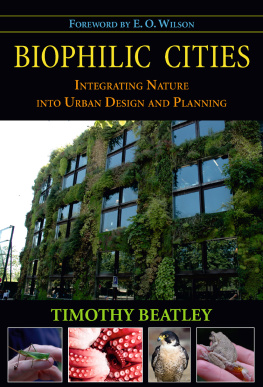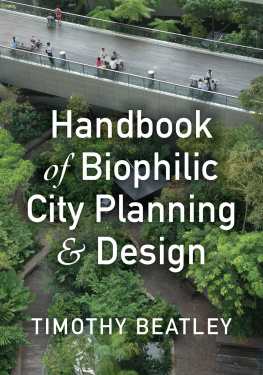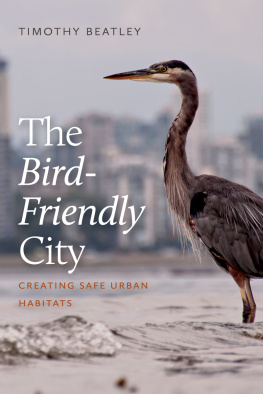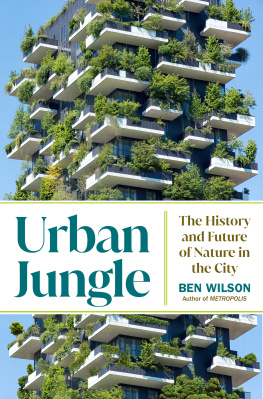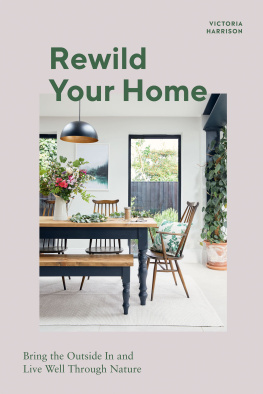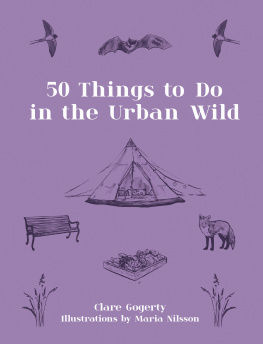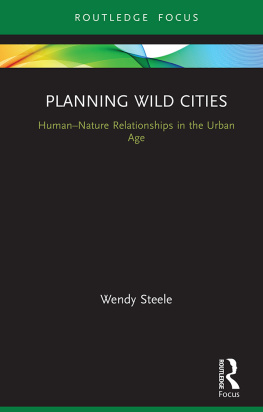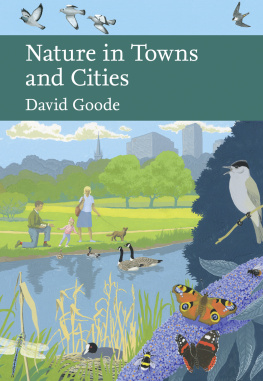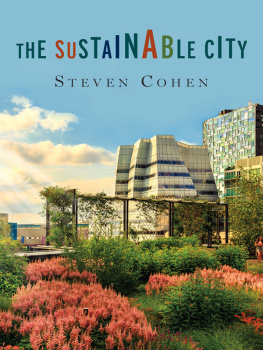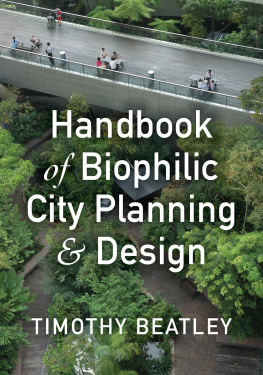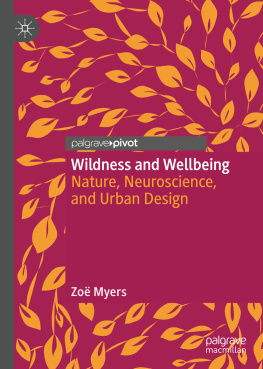Timothy Beatley Biophilic Cities Integrating Nature into Urban Design and Planning 10.5822/978-1-59726-986-5_1 Timothy Beatley 2011
1. The Importance of Nature and Wildness in Our Urban Lives
For several years now I have been administering an interesting slide-based survey to my new graduate students. I call it the what is this? survey, and it consists largely of images of flora and fauna native to the eastern United States. Interspersed are other images, political and corporate. I ask students to tell me everything they can about the images I present, and the results are usually rather discouraging: Few students are able to name even common species of birds, plants, or trees. Sometimes the results are amusing (and would be more so if they werent so sad).
One image I present is of a silver-spotted skipper, a very common species of butterfly. Many students identified it as a moth (not unreasonable), some a monarch butterfly (it looks nothing like a monarch, but apparently this is the only species of butterfly some Americans know of), and several students even thought it was a hummingbird. Only one student in several hundred has correctly identified the species. For me the results confirm what I already knew: For most of the current crop of young adults, nature is fairly abstract and rather general. They grew up in an age of computer games, indoor living, and diminished free time. It is probably not surprising that common species of native flora and fauna are not immediately recognizable, but it is an alarming indicator of how we have become disconnected from nature.
Fortunately the students do not have a blas attitude about this but, encouragingly, a sense of genuine concern about how poorly they fared on this unusual test.
Im certainly not the only one to notice the limited knowledge of our youth about the natural world and to wonder what this might bode for the future of community and environment. Paul Gruchow, a notable Midwest writer and essayist, has been one of the most eloquent observers of this trend. He tells the story of the local town weed inspector who arrives at his home, in response to a neighbors complaint about an unkempt yard, only to be unable to identify any of the offending plants and shrubs in the yard (all of which Gruchow knew, and knew well). More disturbing, Gruchow found that a group of high school seniors he took on a nature walk to a nearby lake were unable to name or recognize even the most common midwestern plants. Gruchow connects this to love, that essential thing that binds and connects us to one another and to the places and natural environments that make up our home. Can you, Gruchow asked those students, imagine a satisfactory love relationship with someone whose name you do not know? I cant. It is perhaps the quintessential human characteristic that we cannot know or love what we have not named. Names are passwords to our hearts, and it is there, in the end, that we will find the room for a whole world.
Richard Louv has ignited new concern and debate about this nature disconnect in his wildly popular book Last Child in the Woods , in which he argues that todays kids are suffering from nature deficit disorder. Too much time spent inside, too much time in front of the TV and computer, too little freedom to explore nature (and too little access to nature in new forms of development), and parental concerns about safety (the bogeyman syndrome, as Louv calls it) are all contributing factors to this nature disconnect.
These concerns dovetail with health concerns about our overweight, sedentary children, but for me they represent an even more dire prospect of future generations of adults who dont viscerally or passionately care about nature, are little interested in its protection or restoration, and will miss out on the deeper life experiences that such natural experiences and connections can provide.
These trends, and these profound disconnects from nature in childhood and adulthood, suggest the time is ripe to revisit how we design and plan our communities and cities. There are many reasons to worry about our loss of intimate contact with nature, and they come together to create a compelling argument for a new vision of what cities could be. I draw from the theory and research associated with biophilia and argue that we need to reimagine cities as biophilic cities. A biophilic city is a city abundant with nature, a city that looks for opportunities to repair and restore and creatively insert nature wherever it can. It is an outdoor city, a physically active city, in which residents spend time enjoying the biological magic and wonder around them. In biophilic cities, residents care about nature and work on its behalf locally and globally.
The Power of Nature
That we need daily contact with nature to be healthy, productive individuals, and indeed have coevolved with nature, is a critical insight of Harvard myrmecologist and conservationist E. O. Wilson. Wilson popularized the term biophilia two decades ago to describe the extent to which humans are hardwired to need connection with nature and other forms of life. More specifically, Wilson describes it this way: Biophilia is the innately emotional affiliation of human beings to other living organisms. Innate means hereditary and hence part of ultimate human nature.
To Wilson, biophilia is really a complex of learning rules developed over thousands of years of evolution and human-environment interaction: For more than 99 percent of human history people have lived in hunter-gatherer bands totally and intimately involved with other organisms. During this period of deep history, and still further back they depended on an exact learned knowledge of crucial aspects of natural history. In short, the brain evolved in a biocentric world, not a machine-regulated world. It would be therefore quite extraordinary to find that all learning rules related to that world have been erased in a few thousand years, even in the tiny minority of peoples who have existed for more than one or two generations in wholly urban environments.
Stephen Kellert of Yale University reminds us that this natural inclin ation to affiliate with nature and the biological world constitutes a weak genetic tendency whose full and functional development depends on suff icient experience, learning, and cultural support. Biophilic sensibilities can atrophy, and society plays an important role in recognizing and nurturing them.
So we need nature in our lives; it is not optional but essential. Yet as the global population becomes ever more urban, ensuring that contact becomes more difficult. While architects and designers are beginning to incorporate biophilia into their work, planners and policymakers who think about cities have lagged behind. The subject at hand raises serious questions about what a city is or could be and what constitutes a livable, sustainable place. I believe there is a need to articulate a theory and practice of city planning that understands that cities and urban areas must be wild and natureful. Wildness , in this book, refers to urban nature, which is inherently human impacted or influenced. Urban wildness is not wilderness as we have traditionally conceived it in environmental circles. It is not distant and pristine, defined by how little humans have used or impacted it, but nearby and nuanced; it is as much defined by its resilience and persistence in the face of urban pressures. It is the indomitable wind and weather, the plants that sprout and volunteer on degraded sites, the lichen and microorganisms that inhabit and thrive on the faades of buildings, and the turkey vultures and red-tailed hawks that ply the airways and ride thermal currents high above urban buildings. Wildness in this book doesnt mean untouched or removed but instead refers to the many creatures and processes operating among us that are at once fascinating, complex, mysterious, and alive. In the urban epoch more than ever we need creative urban design and planning that makes nature the centerpiece, not an afterthought.

